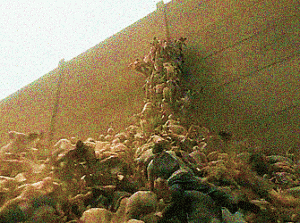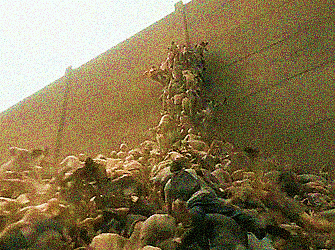 “A Hollywood movie starring Brad Pitt posits a right of return for Arabs and Jews?” asks blogger levi9909 at Jews sans frontieres. An anonymous poster at 1971 Productions blog provides some background on World War Z (with emphasis added and, where applicable, sic):
“A Hollywood movie starring Brad Pitt posits a right of return for Arabs and Jews?” asks blogger levi9909 at Jews sans frontieres. An anonymous poster at 1971 Productions blog provides some background on World War Z (with emphasis added and, where applicable, sic):
According to the novel [by Max Brooks, Metropolitan Books, 2006] a key occurance near the beginning of the zombie pandemic takes place in Israel. While every other nation dismisses the zombie threat as a ‘non-news’ item, Israel takes proactive steps with the closing of its borders to everyone except uninfected Jews and Palestinians.
The book details how the state takes steps to protect itself via the building of “The Wall”, turning the nation into a literal prison state. All Israeli, non-Israeli Jews, and Palestinians and descendants of pre-1948 Palestinians who lived abroad, are allowed to return to Israel to live behind this wall after being screened for the disease. Also in order to scale back on the amount of land it has to secure, the government unwillingly pull back from the West Bank and most other areas they had seized, before sealing themselves in.
… the Palestinians and The Jews ‘live happily ever after’ in peace and unity.
An anonymous commenter replied (again, sic):
I’m pretty certain that if zombies were attacking the Middle East, Israel will only let Jews inside its boarders and let the Arabs and the rest of the world die. They will NOT save the Palestinians. Max Brook’s tries to make the Jews the only civilzed nation on the planet, while all the Muslim nations act crazy and die.
In a trailer scene reminiscent of Colson Whitehead’s poignant Zone One (Anchor, 2011), zombies overrun an enormous wall. I had read Brooks’s dazzling novel, but forgot the details, and was wondering where the wall World War Z’s zombies were scaling was located. Upon watching the movie with my son and learning that it was outside Jerusalem, one couldn’t help but draw a comparison with Israel’s West Bank and two Gaza Strip barriers. Nor the obvious analogy of, as some Israelis see it, hordes of Arabs in the form of Palestinians overrunning their country. Meanwhile, evocations of Christians invading during the Crusades made it especially unsettling to see Jerusalem thus ravaged.
I then watched closely to see if those admitted into the walled compound that Jerusalem had become included Arabs. The fast-moving action and dialogue slipped by me and I was unable to pick out Arabs or hear references to their admittance. In any event, it seemed to have underplayed, as opposed to Brooks’s novel, in which the crisis seems to bring out the best in Israelis.
In his novel, however, either to advance the narrative, reflect his political concerns, or both, Brooks took the opportunity to eliminate two “existential” threats to Israel.
From the 1971 post:
… a threatened yet ironically safe Tehran takes a less than proactive step to quell the sudden influx of Pakistani refugees crossing Baluchistan into Iran. With India all but destroyed by the zombie virus, many Pakistanis who cannot fly out of the country see Iran as the next best alternative. Launching a misjudged nuclear strike against Karachi, Pakistan responds to Iran in a likewise manner, ensuring the annihilation of both countries in the process.
Finally, some brief observations about whether the film works. The case can be made that it’s the zombie film to end all zombie films. Whether all those in the interim since George Romero’s 1978 horror classic Night of the Living Dead – which cashed in on a trifecta of powerful drama, genuine shock, and a social conscience – were even necessary is a moot point. World War Z features the revved-up variety of zombies, which amps up the action, but forfeits the suspense inherent in zombies’ traditional slow gait.
Nevertheless, World War Z is an exciting and moving. Furthermore, the much criticized ending might seem tacked on, in part because it’s scaled down from a cast of skatey-eight million. In a Vanity Fair piece about the problem-plagued making of the film, director Marc Foster said of the final scenes: “The maximum amount of actors or human beings on that set were 20.” Some movies start small and end big; others start big and end small, an arguably more satisfying strategy.

